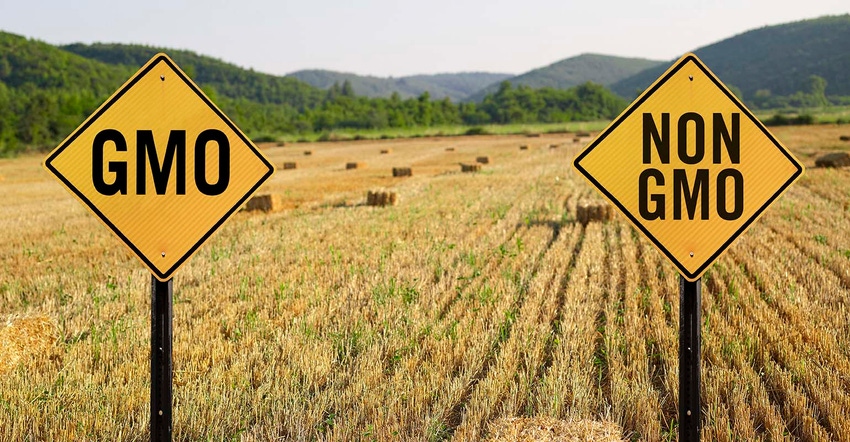Risks of going GMO free
Report highlights the sustainable benefits that could be lost if GMO technology is taken off the table.

Global population and disposable income are on the rise. More disposable income for a grocery bill means shifts in consumer demands. How will the ag industry keep up?
The industry is tasked with protecting the environment and natural resources while also meeting the dietary needs and desires of consumers. Innovation is key, and genetically modified organisms are one tool available to help achieve this mission.
GMO technology provides many opportunities. It can help protect plants from insects and diseases, and can even increase nutritional qualities of food and animal feed. However, consumers have shown reluctance to embrace the technology. Public aversion to GMOs is driven by concerns over safety and environmental impacts, according to the Council for Agricultural Science and Technology.
A recent paper from CAST dives into the benefits of GMO adoption, as well as the potential cost to society if the technology is removed from the marketplace.
GMO Safety
Despite consumer concerns, the CAST paper explains GMO products are safe for consumers. “There have not been any scientifically documented human safety issues associated with food made from commercialized GMO raw materials over the more than 30 years of evaluation,” commentary from CAST explains.
According to a statement from the American Association for the Advancement of Science, “consuming foods containing ingredients derived from GM crops is no riskier than consuming the same foods containing ingredients from crop plants modified by conventional plant improvement techniques.”
Nutritional benefits
Over 820 million people around the globe are currently undernourished, according to the Food and Agriculture Orgnaization. GMOs have the capability to combat this crisis by adding nutrients to improve human health.
Once example of this GMO application is Golden Rice, which received approval for commercial production in the Philippines earlier this year. Golden Rice is biofortified, using GMO technology, with beta-carotene, a precursor to vitamin A.
“In 2019, 22% of children between 21 and 24 months had inadequate levels of vitamin A in the Philippines,” CAST’s paper states. “Statistical simulations indicate that if Golden Rice is substituted for 70% of the currently consumed rice in the Philippines, the prevalence of vitamin A deficiency would decrease by 55-60% in women and approximately 30% in children…”
Consumer benefits
In the U.S., 10.5% of households experienced food insecurity in 2020 according to the Economic Research Service. With limited natural resources and a growing number of mouths to feed, GMOs offer a way to step up production efficiency to fill consumer needs.
“GMOs have contributed to reducing the real cost of food, and consumers would face higher prices if GMO options were removed,” the paper states.
Environmental benefits
If GMOs are removed from the toolbox for farmers, more pesticides would be needed to control insects, weeds and diseases in crops. The increase in pesticide use and pesticide toxicity could negatively affect the environment.
Genetically modifying crops allows less pesticides to be used while growing the plants. According to a 2021 study, GMO eggplants grown in Bangladesh decreased pesticide costs by 38% and reduced the toxicity of the pesticides applied to the crop by up to 76%. Similarly, GMO cotton in India and Pakistan reduced pesticide poisoning by an estimated 9 million instances annually, the paper states.
Endangered species also stand to benefit from GMO technology, CAST explains. The American chestnut tree, for example, was in risk of being eliminated by disease. A GMO chestnut tree was developed to have resistance to the disease. Some environmental organizations that previously firmly opposed GMO crops see promise in the ability of GMO technology to restore environmental diversity.
Regulatory challenges
Currently, the Environmental Protection Agency, Food and Drug Administration and U.S. Department of Agriculture all play a role in regulating most GMOs. Created in 1986, the Coordinated Framework for the Regulation of Biotechnology outlines how the three agencies work together to regulate GMOs.
One motivation for concern among consumers regarding GMOs is the control given to companies developing and patenting GMOs. CAST’s paper summarizes studies showing that biotech and seed companies stand to benefit the most in the U.S. from GMO traits, coming in ahead of U.S. consumers and farmers.
Unfortunately, differences in GMO regulations create a bottleneck in developing and commercializing food, which ultimately reduces food security, according to CAST commentary. “Trade barriers targeted at GMOs reduce access to food, limit fam revenues, and increase overall prices.”
Regulatory challenges also make it hard for public institutions to seek and obtain approval for GMO applications. This further contributes to public aversion of GMOs because of the privatization of the biotech industry.
“GMOs are not a silver bullet and need to be combined with good agronomic practices and future innovations,” CAST’s paper states. “However, without GMO crops as a part of the global cropping systems and food production, the second of the 17 Sustainable Development Goals of the United Nations, to end hunger, achieve food security and improved nutrition and promote sustainable agriculture, will be compromised.”
For more information on this report, visit the CAST website.
About the Author(s)
You May Also Like





